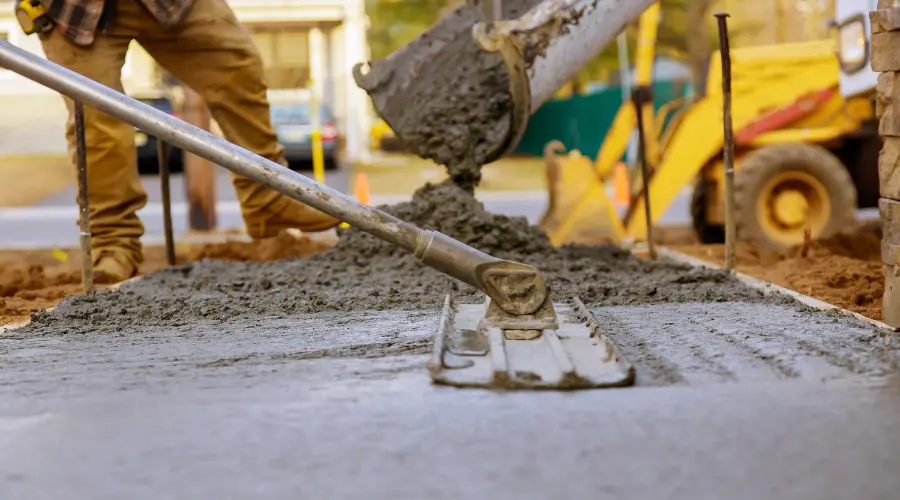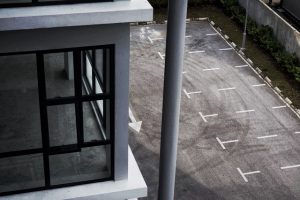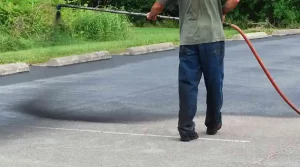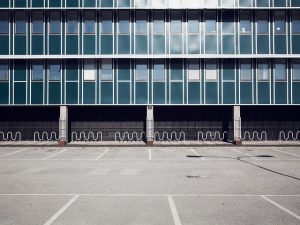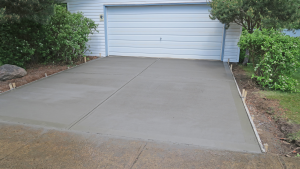Is Your Jersey City Pavement Secretly Deteriorating?
Have you noticed small cracks appearing in your driveway after last winter? Or perhaps that slight dip in your parking area seems to be collecting more water than before? These subtle signs might be your pavement’s desperate cry for help—and ignoring them could cost you thousands.
Jersey City’s unique climate conditions—from humid summers to freezing winters with an average of 25 inches of annual snowfall—create the perfect storm for pavement deterioration. The constant freeze-thaw cycles, combined with heavy urban traffic and proximity to saltwater, accelerate damage in ways many property owners don’t anticipate.
But here’s the good news: catching these warning signs early can save you from complete pavement failure and the hefty replacement costs that come with it. Most serious pavement problems begin as minor, inexpensive-to-fix issues that go unaddressed for too long.
Warning Sign #1: Cracks That Form Patterns
Not all cracks are created equal, and certain patterns signal specific underlying problems:
Alligator Cracking: The Foundation Failure Signal
[Alligator cracking pattern on asphalt pavement]
When your pavement develops interconnected cracks resembling alligator skin, it’s more than just a surface issue:
✓ What it looks like: Small, interconnected cracks forming a pattern similar to animal scales ✓ What it means: Foundation failure beneath the pavement surface ✓ What causes it in Jersey City:
- Inadequate base materials in originally construction
- Poor drainage allowing water to weaken the foundation
- Freeze-thaw cycles common in our northern New Jersey climate
- Heavy vehicle traffic exceeding the pavement’s design capacity
✓ Why it’s urgent: Alligator cracking indicates structural failure that will spread rapidly if not addressed. In Jersey City’s climate, water penetration through these cracks during our rainy spring season will accelerate foundation deterioration.
✓ Repair approach: Professional assessment is critical as this typically requires removal of the damaged section, base repair, and replacement with new pavement materials designed for Jersey City’s climate conditions.
Linear Cracking: The Stress Fracture Warning
Straight-line cracks running across your pavement tell a different story:
- What it looks like: Single lines running across your pavement surface
- What it means: Stress movement in the underlying structure
- What causes it:
- Seasonal ground movement from Jersey City’s freeze-thaw cycles
- Settlement due to improper initial compaction
- Age-related shrinkage of pavement materials
- Poor transitions between different pavement sections
- Why it’s urgent: These cracks allow water to penetrate beneath the surface, where Jersey City’s winter freeze cycles will cause expansion and rapid deterioration.
- Professional solution: Proper cleaning, specialized crack filling materials, and potentially sealcoating to prevent water infiltration.
Warning Sign #2: Sunken Areas and Depressions
When sections of your pavement start to sink or develop bowl-like depressions, it’s time for immediate attention:
What These Depressions Tell You
Sunken areas in your Jersey City pavement may indicate:
- Base failure from water infiltration
- Soil erosion beneath the pavement
- Improper initial compaction during installation
- Underground utility issues (common in older Jersey City neighborhoods)
- Drainage problems allowing water to pool and weaken the structure
The Jersey City Factor
Our region’s combination of:
- Clay-heavy soils in many neighborhoods
- High water table in lowland areas
- Historic underground infrastructure
- Significant precipitation throughout the year
makes properties here particularly vulnerable to subsurface issues that manifest as depressions.
The Danger of Delay
If left unaddressed, these depressions will:
- Collect water, accelerating further damage
- Expand in size with each freeze-thaw cycle
- Eventually develop into full potholes
- Potentially indicate more serious underlying issues
Local Insight: Jersey City’s proximity to the Hudson River means properties in eastern neighborhoods often have higher groundwater levels, making them particularly susceptible to subsurface pavement issues during heavy rain seasons.
Warning Sign #3: Edge Deterioration and Crumbling
When the borders of your pavement begin breaking apart, it signals specific problems:
What Edge Deterioration Looks Like
✓ Crumbling edges along the pavement perimeter ✓ Vegetation growth along borders ✓ Separation between pavement and adjacent surfaces ✓ Uneven edges that once were straight and defined
Why It Happens in Jersey City Properties
Edge deterioration is particularly common here due to:
- Limited lateral support (especially on elevated properties in the Heights)
- Aggressive vegetation growth during our humid summers
- Water runoff patterns typical of our sloped neighborhoods
- Winter plowing damage from snow removal equipment
The Hidden Dangers
This issue is particularly troublesome because:
- It allows water to penetrate beneath the pavement
- It creates a deterioration pattern that accelerates inward
- It often indicates drainage problems that will affect the entire paved area
- It creates tripping hazards and liability issues for property owners
The Professional Approach
Proper edge repair typically involves:
- Removing damaged material completely
- Rebuilding the foundation support
- Installing edge restraints where appropriate
- Proper compaction techniques
- Sealing to prevent water infiltration
Warning Sign #4: Fading and Discoloration
While sometimes dismissed as merely cosmetic, color changes in your pavement often signal important underlying issues:
The Color-Condition Connection
| Color Change | What It Indicates | Urgency Level |
| Gray, bleached appearance | Oxidation, dried out asphalt | Moderate |
| Whitish streaks | Severe moisture damage | High |
| Dark, oily spots | Surface binder failure | Moderate |
| Reddish tint | Aggregate exposure | Moderate to High |
Why Jersey City Pavements Fade Faster
Our local conditions accelerate fading due to:
- High UV exposure during summer months
- Salt exposure from winter road treatments
- Maritime air effects from our waterfront location
- Industrial pollutants in urban areas
Beyond Aesthetics: Why Fading Matters
Color changes aren’t just about looks:
- Oxidation makes pavement brittle and crack-prone
- Binder deterioration reduces structural integrity
- Exposed aggregate accelerates surface breakdown
- Moisture penetration increases when protective oils dissipate
The Restoration Solution
Professional services to address fading typically include:
- Deep cleaning to remove contaminants
- Specialized sealcoating formulated for urban environments
- Oil spot treatment for affected areas
- UV protectants in treatment materials
Warning Sign #5: Drainage Issues and Water Pooling
When water stands on your pavement for more than 30 minutes after rain, you’re facing a critical issue:
Identifying Problematic Drainage
Watch for: ✓ Standing water after rainfall ✓ Water-stained areas on dry days ✓ Algae or moss growth in shaded sections ✓ Erosion patterns along edges ✓ Vegetation growth in pavement joints
The Jersey City Water Challenge
Our local drainage issues are compounded by:
- Combined sewer systems in older neighborhoods
- High water table in lowland areas
- Limited permeable surfaces in urban settings
- Intense rainfall events increasingly common with climate change
The Cascade of Damage
Poor drainage creates a domino effect of problems:
- Standing water softens the asphalt surface
- Softened asphalt allows traffic to create depressions
- Depressions collect more water
- Water penetrates to base layers
- Base materials weaken
- Structural failure follows
Professional Drainage Solutions
Expert paving companies address these issues through:
- Regrading to create proper slope (minimum 2% recommended)
- French drain installation for problem areas
- Permeable pavement options where appropriate
- Catch basin repairs or new installations
- Transition adjustments between different surfaces
Warning Sign #6: Potholes: The Point of No Return
When your pavement develops actual holes, you’ve reached a critical stage requiring immediate professional intervention:
The Pothole Formation Process
Potholes develop through a predictable sequence:
- Water penetrates through cracks or permeable areas
- In winter, that water freezes and expands, creating voids
- During thaw cycles, water undermines the base material
- Traffic pressure causes the unsupported pavement to collapse
- The process accelerates as more water enters the enlarged opening
Jersey City’s Pothole Perfect Storm
Our region experiences the ideal conditions for pothole formation:
- Multiple freeze-thaw cycles each winter
- Heavy precipitation throughout the year
- Dense traffic patterns even on residential streets
- Road salt penetration accelerating deterioration
The Exponential Damage Factor
What makes potholes particularly urgent:
- They expand at an accelerating rate
- Each passing vehicle enlarges the damaged area
- They collect more water, creating a feedback loop of deterioration
- They cause vehicle damage, creating potential liability issues
- They indicate full-depth structural failure
Proper Pothole Repairs
Quality repair involves more than just filling the hole:
- Square-cut preparation of the damaged area
- Full-depth removal of compromised materials
- Base evaluation and repair as needed
- Hot-mix asphalt application (superior to cold patch for permanence)
- Proper compaction to prevent future settlement
- Edge sealing to prevent water infiltration
Warning Sign #7: Surface Raveling and Aggregate Loss
When your pavement surface begins shedding material, creating a rough, pebbled appearance:
What Raveling Looks Like
- Loose stones appearing on the surface
- Rough, irregular texture developing
- Small divots where material has dislodged
- Progressive deterioration from slight to severe
Why It Happens
Raveling occurs when:
- Asphalt binder deteriorates from age and oxidation
- Poor initial installation didn’t properly bind materials
- Excessive water penetration weakens surface cohesion
- Oil and chemical exposure deteriorates the binding agents
The Jersey City Factor
Local conditions that accelerate surface raveling include:
- High UV exposure during summer months
- Salt exposure during winter ice management
- Heavy rainfall washing away deteriorating binder
- Temperature fluctuations causing expansion/contraction stress
The Professional Fix
Expert repair approaches include:
- Surface evaluation to determine severity
- Cleaning and preparation of affected areas
- Application of specialized surface treatments to rebind materials
- Sealcoating to protect and prevent further deterioration
- Possible overlay for advanced cases
The Cost of Waiting: Why Immediate Repairs Save Money
The economics of pavement repair follow a predictable pattern that smart Jersey City property owners understand:
The Pavement Deterioration Timeline
[Graph showing exponential cost increase over time]
| Stage | Typical Repair Cost | If Delayed 1 Year | If Delayed 3 Years |
| Early cracking | $0.50-$1.00/sq ft | $1.50-$3.00/sq ft | $5.00-$8.00/sq ft |
| Moderate damage | $2.00-$4.00/sq ft | $5.00-$8.00/sq ft | Full replacement |
| Severe damage | $5.00-$8.00/sq ft | Full replacement | Full replacement + base work |
The Jersey City Premium
Local property owners face additional cost factors:
- Urban access challenges increasing equipment costs
- Permit requirements for larger repairs
- Premium material costs for climate-appropriate solutions
- Higher labor costs than surrounding regions
Beyond Direct Repair Expenses
Delayed repairs also impact:
- Property value (up to 5-10% reduction for poor pavement)
- Liability exposure from trip-and-fall incidents
- Vehicle damage from severe pavement failures
- Water damage to adjacent structures when drainage fails
Professional Assessment: The Critical First Step
Before undertaking any repair, expert evaluation offers significant advantages:
What Professional Assessment Provides
✓ Root cause identification: Understanding what’s really causing the damage ✓ Repair strategy development: Creating the most cost-effective approach ✓ Material recommendations: Selecting options optimized for your specific conditions ✓ Budget planning: Accurate cost projections for necessary work ✓ Prioritization guidance: Addressing critical issues first when budget constraints exist
Questions to Ask Your Jersey City Paving Professional
When consulting with an expert, be sure to inquire about:
- What’s causing the specific damage you’re seeing
- How urgent the repairs truly are
- What preventative measures could avoid future problems
- Whether partial or complete replacement is more cost-effective
- What warranty coverage is provided for different repair options
Take Action Now: Protecting Your Jersey City Pavement Investment
Don’t let minor pavement issues become major expenses. The unique climate challenges of Jersey City make early intervention particularly important for maintaining your property’s value and functionality.
Our team of local paving repair specialists understands the specific challenges facing Jersey City properties. From the salt exposure of waterfront neighborhoods to the drainage challenges of the Heights, we provide customized solutions that address not just the symptoms but the underlying causes of pavement deterioration.
Ready to stop pavement problems before they escalate?
Contact our Jersey City paving experts today for a comprehensive pavement assessment. Our detailed evaluation will identify existing and potential issues, prioritize repairs, and help you develop a maintenance plan that protects your investment for years to come.
Call (201) 977-4882 now or visit at Jersey City Paving and Concrete to schedule your professional pavement evaluation and receive a customized repair recommendation.

